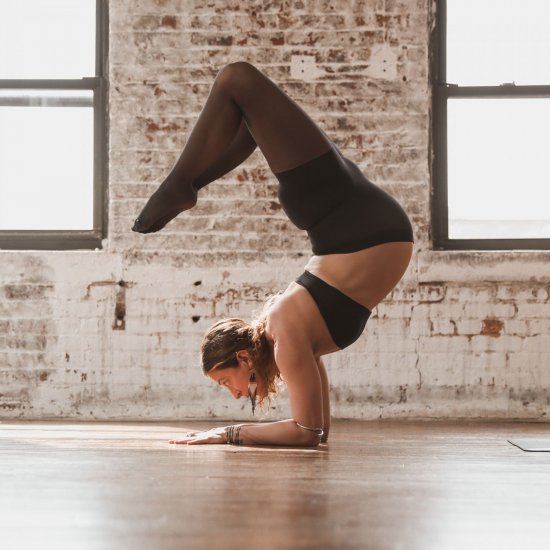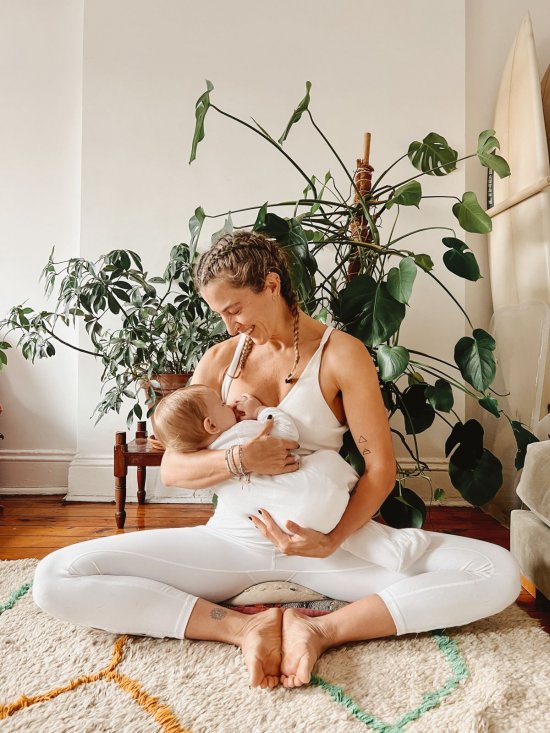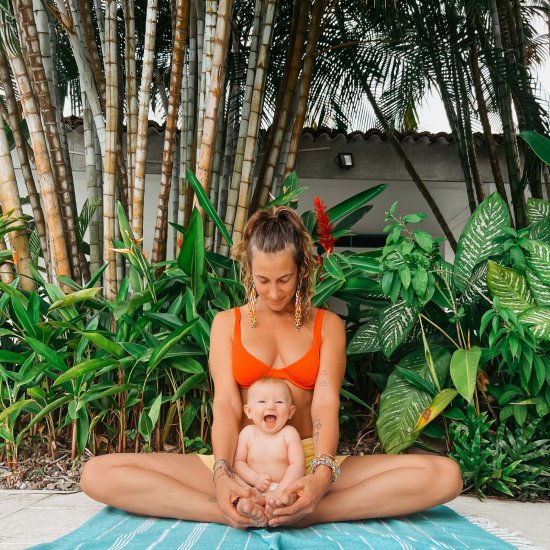
If I could pinpoint one practice that has supported me the most throughout the process of childbirth into motherhood, it would be yoga. Not the type of yoga commonly portrayed on social media, which is mainly the physical aspect of postures (asanas), but the whole of yoga as a transformational method that helps us become balanced beyond the physical realm. After all, what is a more transformational time for a woman than the journey of becoming a mother?
In the Yoga Sutras of Patanjali, one of the most important texts of yoga philosophy, yoga is described as an 8-limb path to enlightenment. Its purpose, as described by Patanjali, is not to attain physical fitness but to cultivate inner peace and self-awareness, to turn inwards and ultimately end our suffering so we can become wiser and happier. It provides a roadmap on how to live life purposefully, emphasizing the nonphysical elements to attain mental clarity and develop spiritually.

photo credit: @ljbnyc1
When we integrate all the aspects of yoga described in the sutras, such as meditation, breath control, postures, and chanting, we are not only connecting deeper to ourselves and our baby (in womb and out), but we are also cultivating the qualities of self-love, calmness, compassion, intuition, body control, inner power, resilience, and selflessness, which are vital in the process of birth, from conception through pregnancy, labor, delivery, and beyond as we become mothers.
Pregnancy is a sacred time of incredible change, inside and out. As we grow a human inside of us, we are called to slow down, to nurture the new life as well as ourselves. It is a time for introspection and accessing deeper meaning as we come to terms with what we are letting go of and who we want to become.
In The Bhagavad Gita, an ancient Sanskrit text that contains some of the most powerful teachings in the practice of yoga, it is said that to be born in human form as the offspring of yogis is the deepest of blessings. We are not just practicing yoga for ourselves, though it has many practical applications; the benefits go beyond us to our children as a blessing, even before they are born.
“[To be born to parents who have practiced yoga and are wise, is a birth fortunate and difficult to obtain.” Chapter 6, verse 41 (The Bhagavad Gita, translated by Stephen Mitchell)
When dealing with the aches and pains that come from the extra weight of carrying a baby in (and, later, out of) the womb and nursing, consistently practicing yoga strengthens and helps heal our bodies so they can come into balance and we can live pain-free during and after pregnancy.
Through the practices of meditation, pranayama, yoga nidra, chanting, and postures, yoga is very effective in reducing uncomfortable pregnancy symptoms such as nausea, headaches, indigestion, lack of energy, and sleepless nights. Yoga works to relax the nervous system, which helps reduce any anxiety, stress, and fear that comes with childbirth and motherhood.

Photo credit:@brendonohue
Birth is probably the biggest marathon that we will ever run. Yoga prepares us, mentally and physically, for this incredible feat, especially through breathwork. The breath is the bridge between past, present, and future. It is the direct portal to our present moment, allowing us to regulate our thoughts, emotions, and bodies. The Hatha Yoga Pradipika, another classic fifteenth-century Sanskrit manual on haṭha yoga, written by Svātmārāma, says, “The mind is the lord of the senses and the breath is the lord of the mind.” If we can learn to control our breath, we are able to control our mind, nerves, bodies, and emotions. I can’t think of any other moment in our lives when we need this the most than through the process of birthing, when we need to tap deeply into our bodies, learn to surrender, and use the breath to stay present and calm beyond anxiety, pain, and fear.
Physically, yoga also helps boost our stamina, improves our flexibility, strengthens the pelvic floor, and ultimately brings balance to the body so we can have an easier birth experience. There are studies that show that women who practice yoga during pregnancy experience significantly lower levels of pain, lower frequency of labor induction, lower percentage of cesarean sections, shorter durations of the second and third stages of labor, and less tears, interventions, and complications overall, plus quicker recoveries.
Postpartum

photo credit: @ljbnyc1
The transition into motherhood can be very difficult on every level, as not only are we called to care for a newborn baby 24/7, but we are also dealing with a sense of loss of our own identity, freedom, and independence. We are exhausted, our bodies get tense and stiff from nursing, co-sleeping, caring, and lifting our babies, and our muscles are stretched and weakened from pregnancy and childbirth. We go through a lot of change after childbirth, and there is a huge mix of all the feels, including exhaustion, soreness, fragility, fear, and excitement. Emotions can also be affected by hormonal changes that happen during pregnancy and postpartum, leading in some cases to postpartum depression.
Postpartum yoga is an incredible tool to regain balance, reconnect to our bodies, and heal. It helps regulate our hormones and stress levels and can hack our mood, bringing us into a state of harmony on all levels, mental, physical and spiritual.
The pelvic floor muscles and core are weakened by pregnancy and childbirth. By practicing yoga, we can heal the pelvic floor and the core gently. I can’t emphasize more how important this is, because the pelvic floor muscles are one of the key muscles in our bodies! The pelvic floor muscles support the bladder, uterus, and bowel. They prevent incontinence of bladder and bowel and prolapse and play an important part in healthy sexual function and pleasure. Yoga postures and some pranayama exercises tone the pelvic floor muscles again and improve circulation to the pelvic region.
Through the practice of all the parts of yoga with postures, pranayama, chanting, and meditation, we can regain mental, physical, and spiritual equilibrium . It doesn’t require a lot of time, just some consistency, to feel the full benefits. Often, as new mothers, we forget to care for ourselves, being so immersed in caring for our newborns, that we let ourselves go in the process. In my experience, taking a short time for daily self-care helps us have a better pregnancy and birth experience and become better mothers.
 The teachings of yoga provide us with the tools to navigate motherhood with grace, cultivate peace, and uncover the boundless potential within us as women, parents, lovers, friends, and human beings. Yoga teaches us to become the best version of ourselves inner and outer so we can be more confident, conscious, loving, and present parents.
The teachings of yoga provide us with the tools to navigate motherhood with grace, cultivate peace, and uncover the boundless potential within us as women, parents, lovers, friends, and human beings. Yoga teaches us to become the best version of ourselves inner and outer so we can be more confident, conscious, loving, and present parents.
Recommended yoga practices from conception to motherhood:
Pranayama: Nadi Shodhana, Bhramari,Ujjayi, Complete yogic breath
Postures: Viparita Karani (legs up the wall), Virabhadrasana (Warriors and lunges), Vrksasana(Tree pose), Malasana (Garland pose), Ardha Kapotasana ( half pigeon), Badhakonasana (butterfly), Adho Mukha Mandukasana (frog pose),Utkatasana (chair), Bitilasana Marjaryasana(cat-cow)
Chanting: Om or “Om Namah Shivaya”
Yoga Nidra
Meditation: loving-kindness, breath, mantra
Please use caution when attempting any of the carries, exercise or activities highlighted on this blog, social media or any other content channels. Please use common sense and caution when using a baby carrier. You should consult a physician before starting any diet or exercise program. For more information, see our disclaimer.



